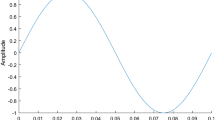Abstract
The discovery of the fast Fourier transform (FFT) algorithm and the subsequent development of algorithmic and numerical methods based on it have had an enormous impact on the ability of computers to process digital representations of signals, or functions. At first, the FFT was regarded as entirely new. However, attention and wide publicity led to an unfolding of its pre-electronic computer history going back to Gauss. The present paper describes the author's own involvement and experience with the FFT algorithm.
Similar content being viewed by others
References
M. T. Heideman, D. H. Johnson, C. S. Burrus,The ASSP Magazine (Oct.) 1984,1, 14.
J. W. Cooley, J. W. Tukey,Math. Comp. 1965,19, 297.
I. J. Good,J. Royal Statist. Soc., Ser. B. 1958,20, 361;1960,22, 371 (MR 21 1674; MR 23 A4231).
C. S. Burrus, P. W. Eschenbacher,IEEE Trans. Acoust. Speech and Signal Processing 1981,ASSP-29, 806.
R. B. Blackman, J. W. Tukey,The Measurement of Power Spectra, Dover, New York, 1959.
W. M. Gentleman, G. Sande,Fast Fourier Transforms for Fun and Profit (1966 Fall Joint Computer Conf., AFIPS Proc. Vol. 29), Spartan, Washington, DC, 1966, pp. 563–578.
L. R. Welch,Computation of Finite Fourier Series (Tech. Report No. SPS 37-37, Vol. 4), Jet Propulsion Lab, Pasadena, CA, 1966. Also,A Program for Finite Fourier Transforms (Tech. Report No. SPS 37-40, Vol. 3), Jet Propulsion Lab, Pasadena, CA, 1966.
J. W. Cooley, P. A. Lewis, P. D. Welch,IEEE Trans. Audio Electroacoustics 1969,AU-17, 77.
J. W. Cooley, P. A. W. Lewis, P. D. Welch,IEEE Trans, on Education 1969,E-12, 27.
P. D. Welch,IEEE Trans. Audio Electroacoustics 1969,AU-15, 209.
J. W. Cooley, P. A. W. Lewis, P. D. Welch,J. Sound Vib. 1970,12, 339.
R. W. Hockney,J. Assoc. Computing Machinery 1965,12, 95.
R. W. Hockney,The Potential Calculation and Some Applications (Methods in Computational Physics, Vol.9), Academic Press, New York, 1970;I.B.M. Research Report R.C. 2870, 1970.
Special Issue on Fast Fourier Transform and Its Application to Digital Filtering and Spectral Analysis,IEEE Trans. Audio Electroacoustics 1967,AU-15, 43.
Special Issue on Fast Fourier Transform,IEEE Trans. Audio Electroacoustics 1969,AU-17, 65.
J. Connes, P. Connes, J.-P. Maillard,Atlas des Spectres dans le Proche Infrarouge de Vénus, Mars, Jupiter et Saturne, Éditions du Centre de la Recherche Scientifique, Paris, 1969.
L. H. Thomas, in:Applications of Digital Computers, Ginn, Boston, 1963.
K. Stumpff,Grundlagen und Methoden der Periodenforschung, Springer, Berlin, 1937; K. Stumpff,Tafeln und Aufgaben zur Harmonischen Analyse und Periodogrammrechnung, Springer, Berlin, 1939.
G. C. Danielson, C. Lanczos,J. Franklin Inst. 1942,233, 365 and 435.
P. Rudnick,Math. Comp. 1966,20, 429.
R. L. Garwin,IEEE Trans. Audio Electroacoustics 1969,AU-17, 69.
J. W. Cooley, P. A. Lewis, P. D. Welch,IEEE Trans. Audio Electroacoustics 1967,AU-15, 76.
C. Runge, H. König,Vorlesungen über Numerisches Rechnen (Die Grundlehren der Mathematischen Wissenschaften, Band XI), Springer, Berlin, 1924.
C. Lanczos,Applied Analysis, Prentice Hall, Englewood Cliffs, NJ, 1956.
C. Lanczos,Discourse on Fourier Series, Oliver and Boyd, Edinburgh-London, 1966.
H. H. Goldstine,A History of Numerical Analysis from the 16th Through the 19th Century, Springer, New York-Heidelberg-Berlin, 1977, pp. 249–253.
C. F. Gauss,Nachlaβ: Theoria interpolationis methodo nova tractata (Carl Friedrich Gauss, Werke, Band 3), Königliche Gesellschaft der Wissenschaften, Göttingen, 1866, pp. 265–303.
J. W. Cooley,How the FFT Gained Acceptance, Proceedings of the Association for Computing Machinery Conference on the History of Scientific and Numeric Computation, Princeton, NJ, May 13–15, 1987.
Author information
Authors and Affiliations
Additional information
The author is grateful for permission from the Association for Computing Machinery to allow the present paper to bear some similarity with the paper,How the FFT Gained Acceptance, ref. [28]
Rights and permissions
About this article
Cite this article
Cooley, J.W. The re-discovery of the fast Fourier transform algorithm. Mikrochim Acta 93, 33–45 (1987). https://doi.org/10.1007/BF01201681
Received:
Issue Date:
DOI: https://doi.org/10.1007/BF01201681




